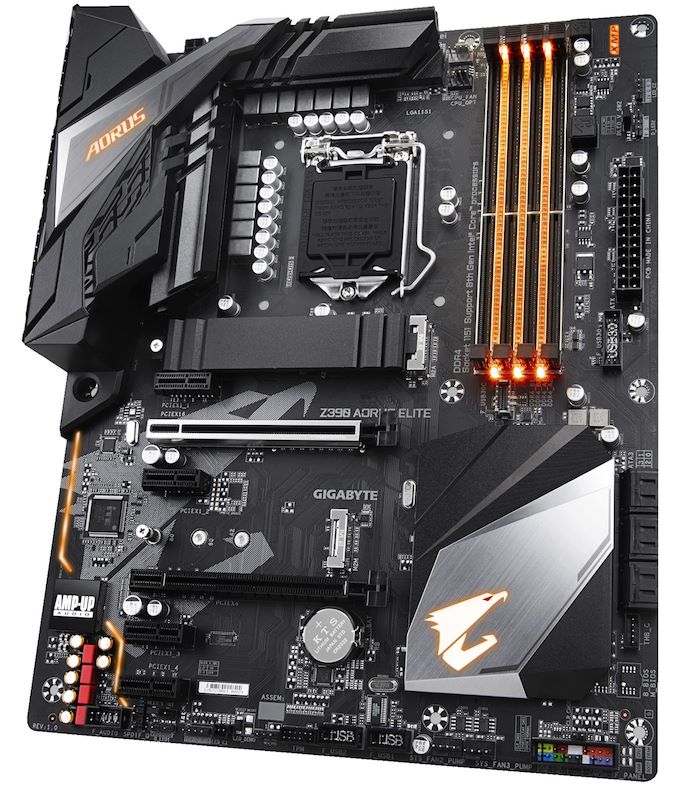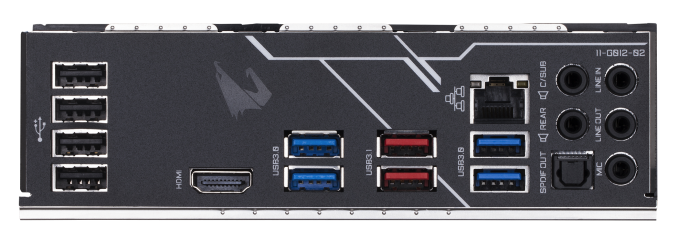Intel Z390 Motherboard Overview: 50+ Motherboards Analyzed
by Ian Cutress & Gavin Bonshor on October 8, 2018 10:53 AM EST- Posted in
- Motherboards
- Intel
- MSI
- Gigabyte
- ASRock
- EVGA
- Asus
- NZXT
- Supermicro
- Z390
GIGABYTE Z390 Aorus Elite
The GIGABYTE Z390 Aorus Elite is a little more 'basic' in terms of aesthetics than the Z390 Aorus Master and although the board has a similar rear panel cover and features integrated RGB LED lighting, the Z390 Aorus Elite belongs to the low to mid-range of Z390 options available. As per GIGABYTE's new naming scheme, one thing we do know is that the Z390 Aorus Elite replaces the Z370 Aorus Gaming 3 in the low-end Z390 entry segment. Official memory support out of the box consists of DDR4-4133 with up to 64 GB supported across four available RAM slots.
On the rear panel, GIGABYTE has included two USB 3.1 Gen2 Type-A, four USB 3.0 Type-A and four USB 2.0 ports. Also featured are a single HDMI video output and a single LAN port controlled by an Intel I219V Gigabit networking chip. The onboard audio is directed by a Realtek ALC1220-VB HD audio codec and offers a total of five 3.5mm audio jacks and a single S/PDIF optical output.
Like the majority of the boards in GIGABYTEs Z390 product stack, the Z390 Aorus Elite is advertised as having a 13-phase power delivery in a 12+1 configuration. The board has two full-length PCIe slots with the top slot with support for two-way CrossFire configurations. In addition to the full-length slots is a total of three PCIe 3.0 x1 slots. In terms of storage, the Z390 Aorus Elite has a total of two M.2 slots with the top slot getting treated to an M.2 heat shield. As with most Z390 motherboards, there is a total of six SATA ports which allows for RAID 0, 1, 5 and 10 arrays to be utilized.
#
The Z390 Aorus Elite is targeted more towards gamers on a budget with an MSRP of $180 and as previously mentioned, replaces the Z370 Aorus Gaming 3 in GIGABYTEs previous product stack making this the cheapest of their Z390 gaming themed ATX sized motherboards. There is no scope for SLI due to bandwidth restrictions on the second full-length PCIe 3.0 x4 slot (SLI requires x8 minimum), but users planning on running an AMD based graphics card can effectively double if they so wish.












79 Comments
View All Comments
Smell This - Tuesday, October 9, 2018 - link
Much.Of.
The.
Same.
2 HSIO lanes per Gen 2 port and WiFi. Wow (rolling I-eyeballs) ...
MadAd - Tuesday, October 9, 2018 - link
58 motherboards, only 13 of which are smaller than ATX. When on earth are we going to move off this outdated oversized format? Its just more of the same every time, so depressing.gavbon - Wednesday, October 10, 2018 - link
13 is better than 0, or 12 :DMadAd - Wednesday, October 10, 2018 - link
Considering very small form formats (ITX) are harder to build for and only 7 are uATX, a size which is the most useful to transition away from ATX then no, it feels like an afterthought from a lazy industry. I mean who uses more than 1 main video card and 2-4 sticks of ram in a gaming PC these days? Even water builds into uATX isnt that hard to accomplish.After literally decades ATX should be a choice for edge cases not a mainstream build.
shaolin95 - Monday, October 22, 2018 - link
who cares about midge boards!Edkiefer - Wednesday, October 10, 2018 - link
All these MB with 2x 8 pin power inputs, is both mandatory and if so I guess new PSU will need 2x 8pin now.entity279 - Wednesday, October 10, 2018 - link
so it's ok to just buy SM motherboards now with them being involved in a security scandal?gavbon - Thursday, October 11, 2018 - link
I currently have the Supermicro C9Z390-PGW awaiting to go on the test bench next week, so from a consumers standpoint, I could potentially shed light on that board. As far as the Chinese/Supermicro/Spy scandal goes, I don't want to speculate without the finer details.eastcoast_pete - Wednesday, October 10, 2018 - link
Ian & Gavin, thanks for the overview.@ both - Question: I've read that Intel, to deal with its bad planning/capacity problems on 14 nm, has contracted the fabbing of some of its chipsets out to TSMC, specifically in TSMC's 22 nm tech. Is that correct, and did you have a chance to confirm that the new 390s used by these boards are indeed made by Intel on their 14 nm FinFET tech, or are they made by a contractor (TSMC)?
DanNeely - Wednesday, October 10, 2018 - link
AFAIK the chipsets being reverted to 22nm are using Intel's 22nm process in old unupgraded fabs. Doing so would be far less work than porting to a process from a different company; the latter would require massive rework to follow a completely different set of design rules.